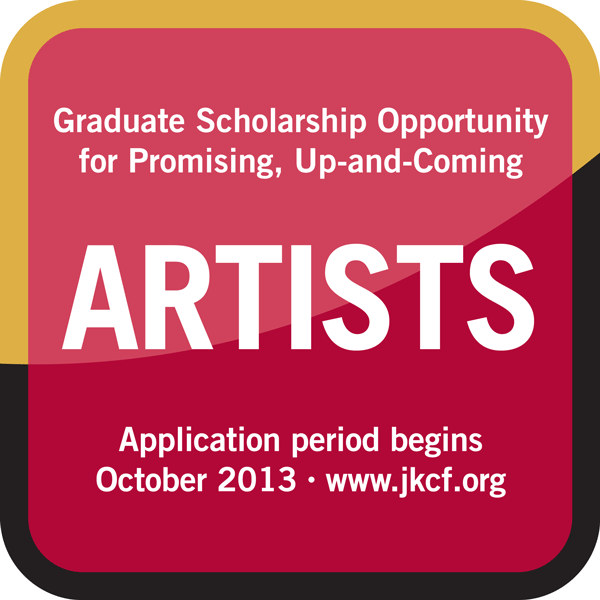Advice for Art Students Deciding on What's Next
We found a compelling blog post for young artists on the Huffington Post. Turns out that blogger, Clara Lieu, writes weekly for the Huff Post and is a visual artist, author and adjunct professor at the Rhode Island School of Design. Clara is on Twitter and makes her email available at the end of the article below.
 JKCF wants visual and performing artists as well as creative writers seeking an MFA to check out one of the most generous scholarships for artists in the nation – the Jack Kent Cooke Graduate Arts Award. This award enables students or recent alumni with exceptional artistic or creative promise and financial need to pursue up to three years of study at an accredited graduate institution in the U.S. or abroad. Awards can be as much as $50,000 annually. In 2014, the Foundation will select up to 20 recipients. The application is open through November 26. The selection criteria and eligibility are rigorous but the opportunity for receiving such an award could be life-changing.
JKCF wants visual and performing artists as well as creative writers seeking an MFA to check out one of the most generous scholarships for artists in the nation – the Jack Kent Cooke Graduate Arts Award. This award enables students or recent alumni with exceptional artistic or creative promise and financial need to pursue up to three years of study at an accredited graduate institution in the U.S. or abroad. Awards can be as much as $50,000 annually. In 2014, the Foundation will select up to 20 recipients. The application is open through November 26. The selection criteria and eligibility are rigorous but the opportunity for receiving such an award could be life-changing.
![]()
Ask the Art Professor: Advice for Young Graduates
By Clara Lieu

“I just finished my BFA, where I specialized in painting and drawing, graduating in spring 2013. I am now living back in my hometown. I work at a restaurant as a dishwasher and am living back at home with my parents. I try to go to art openings in the city near where I live. I also have a small studio that I share with three other people and the rent is very affordable for me. I am in an odd point in my life though. I love painting so much and work on painting every single day. I don’t know what to do for next year. I come from a working class family and money has always been a tough issue for me. I get depressed sometimes, thinking about how expensive life is. I want to live in a cosmopolitan international city to pursue grad school. But I stress about the money all the time. What is your advice to young students who have just graduated from their undergraduate degree?”
Life immediately after art school can be traumatic. Most art students go through immense culture shock when they transition from art school into the “real world.” Going from being intensely saturated with artistic activity and other artists to almost nothing can be incredibly depressing and difficult to deal with. Feelings of isolation are common for young artists, and many find themselves at a loss for how to begin and what to do.
My greatest piece of advice is to be as proactive as humanly possible. Many young artists get caught up in what they can’t do. In doing so, they deplete their energy by focusing on the obstacles and limitations that are in the way of what they want. The problem with this approach is that you can end up convincing yourself that you are helpless with your hands tied behind your back.
The truth is, you are never helpless. Instead, focus on what you can do. Get creative with the supplies, facilities and time that’s available to you at the moment. You’ll be amazed at what you can accomplish. When I was a young graduate, I couldn’t afford a studio space, so I purchased a small, inexpensive printing press and made a series of 4″ x 5″ drypoint prints (a non-acid intaglio printmaking technique) in my apartment living room. I had a friend in graduate school who used to get some of her supplies for her sculpture from the garbage on the streets of New York City. One of my colleagues works with nothing but paper towels, cardboard and Elmer’s glue.
Once you’ve developed the circumstances to be creating your work, be sure that you never, ever stop making your art. The first year out of school, I hardly made anything. I told myself that I was too exhausted from my day job, that I had no studio space, that I couldn’t afford art supplies. I sketched in my sketchbook every once in the while, went to the occasional life drawing session, but nothing remotely substantial or even skimming the level of production I was at in art school.
So what happened? Someone gave me a sorely needed wake up call. By chance, I ran into one of my former professors who I really liked and respected tremendously. We chatted and then he asked me, “So, how is your artwork going?” I felt so ashamed to tell him that I wasn’t making anything, and ran through my list of excuses. He firmly stated, “Clara, you were one of my best students, you have to make your art.” He gave me his contact information and agreed to look at my artwork now and then. Knowing that someone was out there looking out for me got me incredibly motivated to make my work. We’ve sustained our relationship now for over 15 years, and to this day, I look forward to our regular conversations with enthusiasm.
This brings me to the next thing you can be proactive about: building your own artistic community through artist friends and mentors. As intimidating as it might seem at first, don’t be afraid to call or email one of your former professors to ask for help and advice on a regular basis. I’m so glad that I forced myself to get over that fear and contacted my former professors early on. Most professors are happy to hear from former students, and they can provide practical guidance for how to navigate life as a professional artist. They will understand better than anyone else where you are coming from and commiserate with your struggles. Even as a mid-career artist, I find conversations with my mentors to be compelling and important.
Ask the Art Professor is a weekly advice column for visual artists. Submit your questions to clara(at)claralieu.com